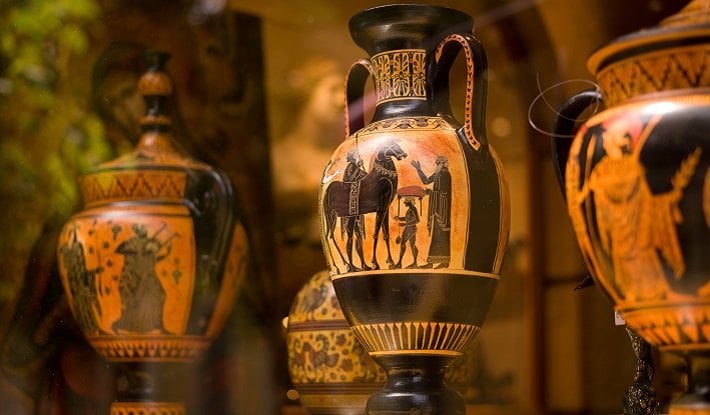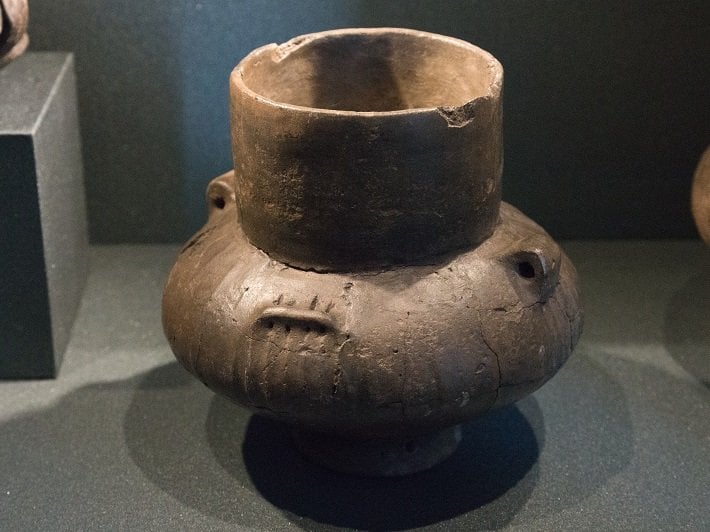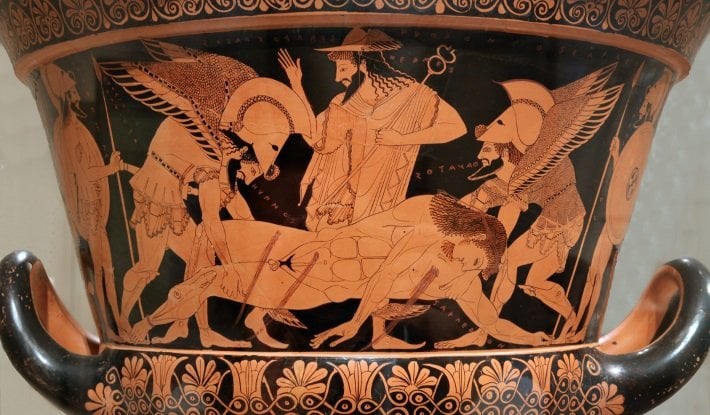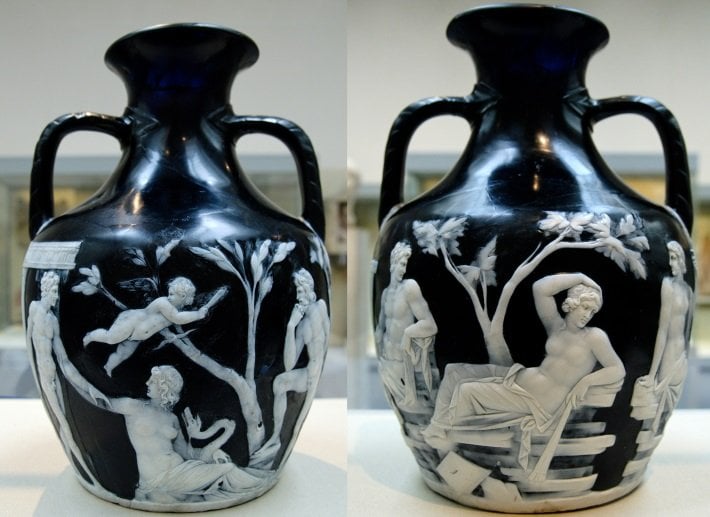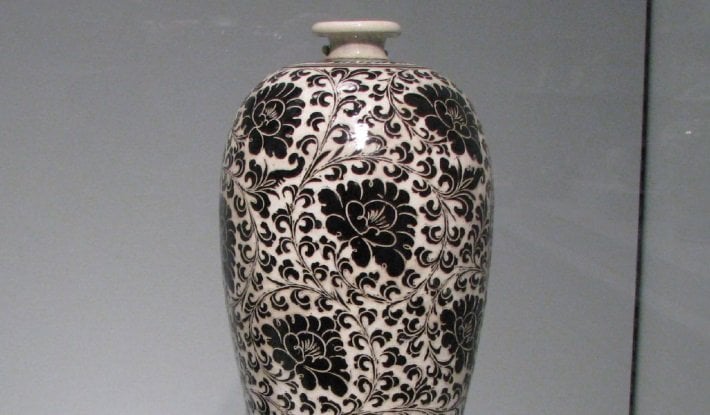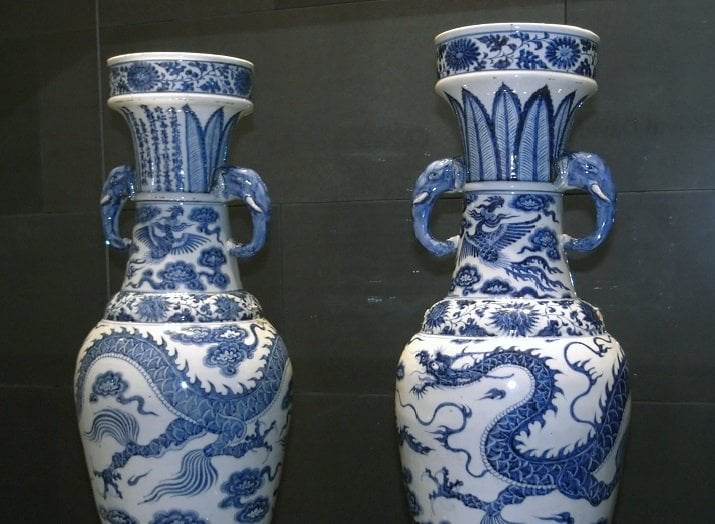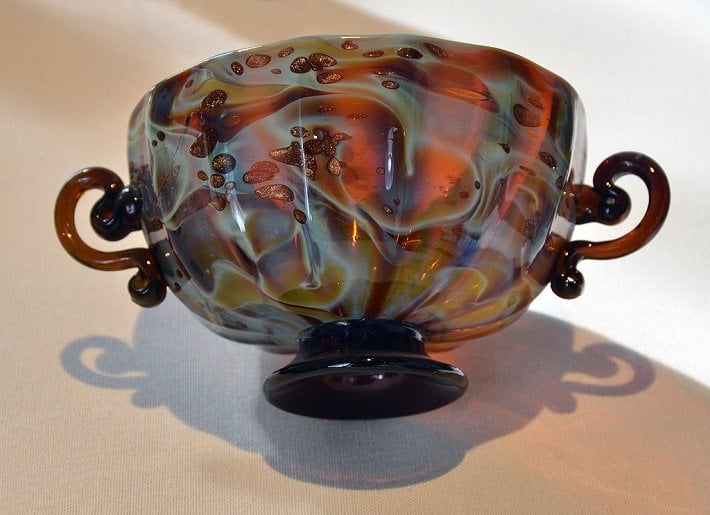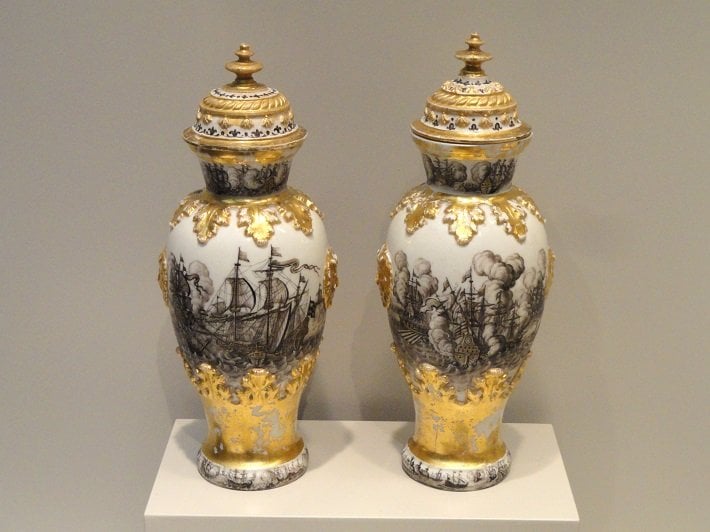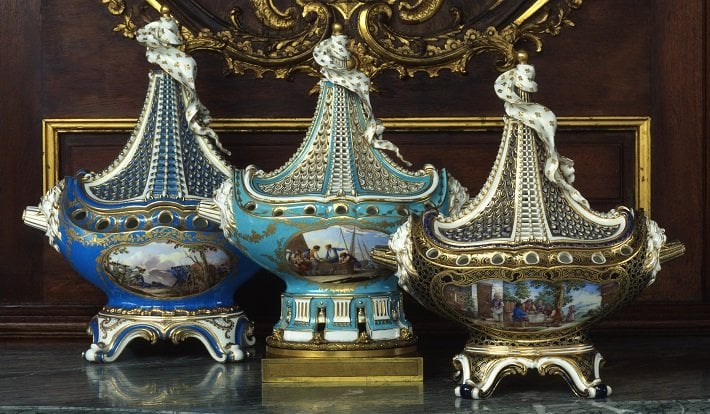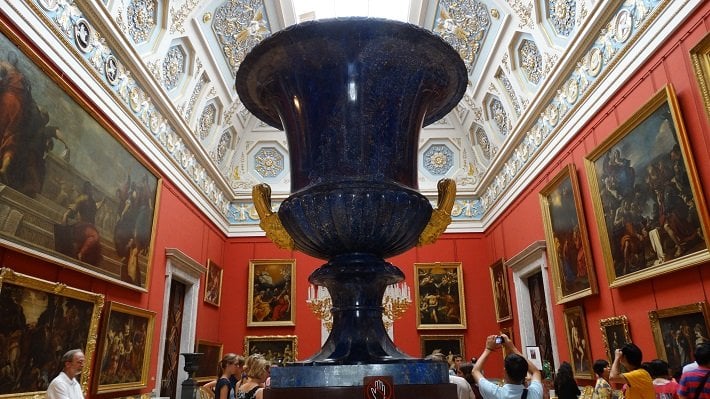If Roger Federer successfully defends his Australian Open tennis title this January, he'll win three things: a place in the record books, £2.32 million in prize money, and a vase.
Though it might seem like the least impressive prize, this vase - the trophy known as the Norman Brookes Challenge Cup - is a superb feat of craftsmanship. The wide-rimmed, twin-handled, silver gilt vase is strikingly beautiful and is actually a model of a famous 2nd Century AD Roman vase, known as the Warwick vase.
Today we might think of vases as little more than vessels for flowers, but they in fact have multiple uses in modern culture: as storage containers, commemorative objects, pots for trees and flowers, decorative items, gifts, and even trophies.
The reason for this is simple. Vases have occupied a unique place in human history, with most of the vase designs and uses we have today being established centuries ago. Indeed, the practice of giving vases as trophies is one which dates back to Ancient Greece.
This blog post tells the story of how vases have been used throughout history and how they have played a role, not only as practical objects, but as some of the most beautiful pieces of art ever made.
Early creations and the potter’s wheel
The very first vases we know about weren't decorative at all, but rather used for storage. The oldest vases which have survived into the present day date back as far as the Bronze Age, where we have evidence of vases being used to contain large quantities of grain and oil.
The round form of vases such as these suggests they were made on a revolving pottery wheel, which allowed for vases to be made in a circular shape. The first known revolving wheels used for the creation of vases have been found in Mesopotamia and date back to 3000 BC.
Amphora from the Middle Bronze Age (1700-1500 BC), used for the storage of grain and oil, held at the City of Prague Museum. © Zde via Wikimedia Commons
Decorative vases and ancient Greece
The ancient Egyptians are thought to be the earliest civilisation to have used vases for decorative purposes. Indeed, it was in ancient Egypt that we have the first evidence of vases being used to store flowers, as we do today. These vases were, however, quite basic in shape and design.
It was the ancient Greeks who are best known for having produced beautiful vases that could be both decorative and functional.
The Greeks had a number of different uses for their vases, but their discovery of new ways of decorating these vases meant that they acquired new, symbolic meanings.
Ancient Greek vases went by a number of different names, based on their uses. Amphorae were used for storing food, oil and wine, hydria were for storing water, alabastra were small containers used for storing oil and perfume, and large kraters were used for mixing wine with water.
Each type of vase in ancient Greece had a specific shape, corresponding to a specific purpose. Greek vases, though, are most famous for their red and black decorations, which allowed for ornament and narrative. Vases were often decorated with images of scenes from everyday life.
A brilliant example of an ancient Greek vase is the Euphronios Krater, crafted in about 500 BC. On one side of this stunning vase is the heroic death scene of the Greek hero Sarpedon; on the other side there is a scene of anonymous youths arming for battle.
The message hidden within the narrative is clear: death can come for all, hero and ordinary man alike. The narrative depiction on the vase reflects the concerns of everyday human existence and the transience of life.
Euphronios Krater, depicting the death of Sarpedon
Decorating vases therefore meant that vases could serve purposes other than simply storing food and wine.
The first use of a vase as a trophy, for example, dates to Ancient Greece, when the winner of the Olympic Games would receive an amphora filled with sacred olive oil.
And vases in Ancient Greece were also used for commemorative purposes. The ancient Athenians, for example, would cremate their dead and store their ashes in an urn, a practise that still widley exists to this day. Luxuriously painted funerary vases were placed on the graves of elite men and women as a mark of their wealth and power.
Vases in ancient Rome
Roman vases continued many of the same traditions as Greek pottery, but as decorative objects they were more likely to be sculpted and carved with reliefs than painted.
In applying these new techniques for producing vases, the Roman Empire produced some of the most impressive and influential vases of all time.
The Medici and Borghese Vases
These include the notorious Medici and Borghese vases, both of which are monumental bell-shaped urns with carved reliefs on their sides, now housed at the Uffizi Gallery (in Florence) and the Louvre (in Paris) respectively.
In these pieces we see a new use for vases. Together with the Warwick vase (the previously mentioned vase which inspired the design of the Australian open mens' singles trophy), these enormous urns were built as garden ornaments for Roman palaces.
Each of these vases were greatly admired upon their rediscovery in Renaissance Italy and their iconic designs have since been extensively reproduced, notably including a famous 'jasperware' production by the 18th Century British potter, Josiah Wedgwood.
The Portland Vase
Perhaps most famous of all is the Portland vase, a simply stunning vase made of violet-blue glass and featuring seven white glass cameo figures, now housed in the British Museum in London.
The Portland vase is the result of a short period in Roman history that experimented with the glass blowing techinique, which had been discovered in around 50 BC.
What is intriguing about the Portland vase is its iconographic decoration. The meaning behind the scenes depicted remain unknown, but it’s possible that the images on the vase are in fact metaphors for the political situation in Rome at the time, concerning the rule and status of the Emperor Augustus.
The Portland vase was not merely decoration: it was propaganda.
The Portland Vase front and back view, 1st Century AD. © Marie-Lan Nguyen via Wikimedia Commons
Chinese vases and the discovery of porcelain
At the same time that the ancient Romans were producing fine vases crafted from clay and ochre, Chinese potters were producing wares using a different technique.
This technique involved firing the mineral kaolin at extremely high temperatures, and it produced a material which would later become known as porcelain.
Archaeological finds date the production of porcelain-like wares in China as far back as the Han Dynasty, which ruled from 206 BC – 220 AD.
The development of porcelain in China changed the history of vase-making forever. Porcelain is often considered the finest type of pottery, on account of its bright white colour, delicacy and strength, and, unlike European earthenware, Chinese porcelain was resistant to both heat and water.
In the history of vase-making, the discovery of porcelain was key as it allowed for the production of beautifully-decorated vases, in a way that wasn't previously possible.
The Chinese porcelain vases produced during the Tang Dynasty (618-907 AD) were designed to hold specific varieties of flowers, each of which had a different symbolic function in China.
The meiping vase, for example, was used to display plum blossoms, symbolic of hope and strength. Meiping literally translates as ‘plum vase’. Likewise, many astonishingly precious porcelain vases were created to hold peonies, the most revered of all flowers in China.
An example of a 13th Century meiping vase, used to hold plum blossoms. © Gary Stephens via Wikimedia Commons
Production of impressive porcelain vases continued into the period of political fragmentation after the end of the Tang dynasty, and again into the Song (960–1279) and Yuan (1271–1368) dynasties.
It was particularly towards the end of the Yuan dynasty that porcelain production took on new, more technologically advanced forms, including techniques to decorate vases with the now-iconic blue and white design, as below.
Top half of the so-called 'David vases', perhaps the most famous porcelain vases in the world, which can be dated precilsely to AD 1351. They date from the very end of China's Yuan Dynasty and once belonged to the famous collector Percival David, now in the British Museum. © Daderot via Wikimedia Commons
Despite the progress made during these centuries, however, it is the Ming Dynasty (1368–1644 AD) which is most famously associated with antique Chinese porcelain, and blue and white vases in particular.
Porcelain vases produced during the Ming Dynasty, known as Ming vases, remain exceptionally highly prized today, and such works sell for colossal sums.
Italian glass vases in the Middle Ages
Whilst some of the most important vases of all time were being crafted in China, European vase making, after the collapse of the Roman Empire, had fallen into decline.
The production of decorative vases - particularly glass vases - was only truly continued in certain areas such as the Italian island of Murano, then in the Republic of Venice.
Murano has a rich source of pure silica sand, and the glassmakers of Murano learned how to mix silica sand with soda ash to create a superior form of glass used for vases and other adornments.
The skill of Murano glassmakers gave Venice a monopoly on vases and adornments made from glass and crystal.
Suddenly, vases once again became popular with the wealthy and aristocratic classes in Europe, who commissioned expensive cut glass vases from the finest Venetian craftsmen.
Late 17th Century Murano glass vase, at the Museum of Glass in Murano. © Vassil via Wikimedia Commons
Chinese and Japanese porcelain vases in Europe
When a Portuguese trading post was set up in Macao in 1557, the first examples of Oriental porcelain entered into Europe.
These included vases from China, and in time, several varieties of vases from Japan, where the secret to porcelain production was discovered around the middle of the 17th Century.
In 16th Century Europe, Chinese imported porcelain was regarded so highly that the term 'china' became synonymous with any porcelain ware, and remains in use today.
However, the techniques and materials used to create Chinese porcelain were not yet understood, and so second rate, soft-paste creations were made in Europe during this period.
It wasn't until the early 18th Century that European ceramicists learnt how to produce wares in hard-paste porcelain. Yet when they did, they used their newfound skills to produce some of the most impressive and beautiful vases of all time.
Many of these early European porcelain vases consciously copied Eastern styles of decoration. German porcelain makers during the 18th Century, for example, decorated vases in a similar way to the Kakiemon porcelain vases of Japan.
European porcelain vases in the 18th and 19th Centuries
The new understanding of porcelain production in Europe allowed for the production of highly decorative vases, with ground-breaking fineness of detail and quality.
It is therefore unsurprising that these vases became extremely fashionable and were enthusiastically collected by the Royalty and nobility of Europe.
Diplomatic gift-giving was a central part of European court politics in the 18th and 19th Centuries, and these new vases were perfect for giving as gifts.
The history of vases had changed once again: where they were once simply a decorative object, in this new phase vases had become powerful tools to communicate power, wealth and prestige.
European vase makers, the most celebrated of which are listed below, quickly became wealthy and important, as they gained patronage from European rulers.
Meissen porcelain vases
European rulers had set their potters the task of copying Chinese manufacturing techniques since the 17th Century.
These efforts finally came to fruition in 1708, when the German potter Ehrenfried Walther von Tschirnhaus discovered the technique in the small Saxon town of Meissen, near Dresden.
It was only a few months after his historic discovery that von Tschirnhaus died, leaving his workshop, which would eventually become the Meissen Porcelain Manufactory, in the hands of the alchemist Johann Friedrich Bottger.
Early Meissen porcelain vases, dating from c. 1715-1720, decorated with scenes of hunting.
Under Bottger, the technique for producing porcelain was kept strictly secret. Betrayals, however, did happen and many of Meissen’s rivals tried to produce fake pieces.
The outbreak of forgery in the first half of the 18th Century led to Meissen developing a distinctive mark for their pieces: blue crossed swords, which to this day are still painted by hand on all of the pieces.
Sevres porcelain vases and the emergence of the potpourri vase
The Meissen manufacturers were so successful that they became the subject of great envy across the continent.
The French king of the period, Louis XIV, granted privileges to any potter who attempted to imitate this technique, and it was this investment which led to the creation of the great 18th Century Sèvres porcelain factory in France.
The French firm of Sèvres, founded in 1738, soon began to create fine hard-paste porcelain items too, using Meissen’s secret.
Sevres quickly became renowned for its vases, in part because 18th Century French society used vases more than any other European country, for a very specific purpose: potpourri.
The tradition of making potpourri, or mixing dried plant materials and spices to produce sweet fragrances, had been popular in France since the early 17th Century.
Perhaps the most famous vases ever produced by the Sevres factory were a set of potpourri vases, designed to look like ships, made in the 1750s for the mistress of King Louis XV, Madame de Pompadour.
It was these Sevres vases that gave rise to the popularity of highly decorative potpourri vases across Europe in the 18th and 19th Centuries.
Sevres porcelain's famous potpourri vases; note the pierced, slotted lids which allow the scent to diffuse slowly © Waddesdon Manor, National Trust via Wikimedia Commons
As well as producing potpourri vases, practical items for the French court, Sevres also produced a number of beautiful vases which were given as diplomatic gifts to other European rulers.
Russian Imperial vases
The practice of giving a precious vase as a diplomatic gift took off in Russia, most notably during the reign of Tsar Nicholas I (1796-1855).
It was during this period in Russia that vase making was considered to be on a par with the traditionally 'highest' forms of art of painting and sculpture.
Russian makers not only used porcelain, but produced some of the most important and impressive vases ever made in glass, enamel and other precious stones and metals.
Russia commanded vast natural resources which it could use to make vases. Vases made from the minerals malachite, jasper and lapis lazuli came in particular to be associated with the Russian Empire in the 19th Century, due to the many lapidary workshops and factories which were established in this period.
The impressiveness of Russian vases owed a lot to their size: Russian noblemen needed enormous vases to fill the vast rooms of their St Petersburg palaces.
Monumental vases, like ones produced by the Imperial Porcelain Factory, were presented every year to the Royal Family on occasions such as Christmas and Easter.
The Badakhshan vase, an enormous lapis lazuli vase in the Hermitage Museum, St Petersburg. © randreu via Wikimedia Commons
Vases in the modern era
The onset of industrialisation in Europe meant a new chapter once again in the history of vases. The mass production of vases at a lower cost meant that decorative vases could be owned by a wider section of society, including Europe’s expanding middle classes.
Despite this, many fantastic vases were still produced for Europe’s royalty and nobility in the 19th Century. Silver vases in particular were associated with luxury and wealth in this period, and were regarded as highly fashionable for the upper classes of the 19th Century.
Production of fine vases continued well into the 20th and 21st Centuries, in a whole variety of new styles, including the naturally-inspired Art Nouveau style and the fashionable 1920s Art Deco style.
The enduring relevance and importance of vases as an artistic medium was underlined when, for example, the British artist Grayson Perry won the prestigious Turner Prize in 2003 for his vases.
Alongside the production of new vases, the 20th and 21st Centuries have seen a keen interest among consumers for the vases of the past.
Antique vases continue to attract buyers for the splendour they can provide to an interior space, whilst collectors seek out the best vases to add to their collections. Undoubtedly Roger Federer will be hoping to add to his.
Browse Mayfair Gallery's collection of antique vases.




